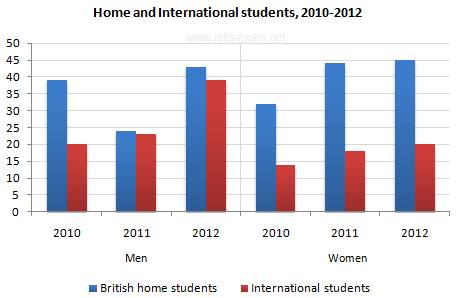The bar chart below gives information about the number of students studying computer science at a UK university between 2010 and 2011
The bar chart presents the number of students studying computer science at the university in Britain from 2010 to 2012. Overall, it can be seen that there are two kinds of students: British home students and International students. British home students dominated quantity of computer science students in the UK for three years in both of females and males.
Between 2010 and 2012, British's home female students had the highest number in 2012 at 45 percent while the lowest number in 2010 around 30 percent. In the opposite, International students had dramatically lower than native students. Females who were studying abroad increased steadily from less than 15 percent (2010) to 20 percent (2012).
In 2011, British male home students had the lowest proportion. By 2012, the number of male students came from British country had increased from less than 25 percent in 2011 to the highest proportion at approximately 43 percent. On the other hand, International male students climbed from 20 percent in 2010 to nearly 40 percent in 2012.
The bar chart presents the number of students studying computer science at the university in Britain from 2010 to 2012. Overall, it can be seen that there are two kinds of students: British home students and International students. British home students dominated quantity of computer science students in the UK for three years in both of females and males.
Between 2010 and 2012, British's home female students had the highest number in 2012 at 45 percent while the lowest number in 2010 around 30 percent. In the opposite, International students had dramatically lower than native students. Females who were studying abroad increased steadily from less than 15 percent (2010) to 20 percent (2012).
In 2011, British male home students had the lowest proportion. By 2012, the number of male students came from British country had increased from less than 25 percent in 2011 to the highest proportion at approximately 43 percent. On the other hand, International male students climbed from 20 percent in 2010 to nearly 40 percent in 2012.

home_and_internation.jpg
